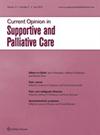世界卫生组织指南:新与旧。
IF 2
4区 医学
Q3 HEALTH CARE SCIENCES & SERVICES
Current Opinion in Supportive and Palliative Care
Pub Date : 2024-09-10
DOI:10.1097/spc.0000000000000722
引用次数: 0
摘要
综述目的 世界卫生组织(WHO)最初的癌痛指南于 1986 年发布,并在全球范围内使用。更新版指南于 2018 年发布。本综述对 "新""旧 "指南进行了比较,并对世卫组织镇痛阶梯在当前环境下的相关性进行了深入探讨。最新发现新指南提供了一份更加循证、严谨的文件,包括与放射治疗管理相关的建议。新指南更详细地关注了阿片类药物的安全处方、阿片类药物的管理以及在癌症治疗早期整合疼痛管理专业知识的重要性。尽管某些疗法被广泛使用,但仍缺乏相关证据,尤其是与辅助治疗有关的疗法。新指南提供了更多与临床实践相关的详细建议,重点关注阿片类药物处方的安全性,使其在当前形势下具有现实意义。世界卫生组织最初的镇痛阶梯不再被推荐为严格的癌痛治疗方案。本文章由计算机程序翻译,如有差异,请以英文原文为准。
The WHO guidelines: the new and the old.
PURPOSE OF THE REVIEW
The original World Health Organisation (WHO) cancer pain guidelines were published in 1986 and used globally. Updated guidance was released in 2018. This review compares the 'old' with the 'new' with a closer look at the relevance of the WHO analgesic ladder in the current climate.
RECENT FINDINGS
The new guidelines provide a more evidence based, rigorously developed document including recommendations relating to radiotherapeutic management. There is a more detailed focus on safe opioid prescribing, opioid stewardship and the importance of integrating pain management expertise early on in the cancer journey. There remains a lack of evidence for certain therapies despite their widespread use particularly in relation to adjuvants. The pitfalls of the original renowned analgesic ladder are highlighted including a recognition that omitting 'step 2' is safe, feasible and cost effective.
SUMMARY
The new guidelines offer more detailed recommendations relevant to clinical practice with a strong focus on safety of opioid prescribing making it relevant in the current climate. The original WHO analgesic ladder is no longer recommended as a strict protocol for cancer pain management.
求助全文
通过发布文献求助,成功后即可免费获取论文全文。
去求助
来源期刊

Current Opinion in Supportive and Palliative Care
HEALTH CARE SCIENCES & SERVICES-
CiteScore
3.70
自引率
0.00%
发文量
54
期刊介绍:
A reader-friendly resource, Current Opinion in Supportive and Palliative Care provides an up-to-date account of the most important advances in the field of supportive and palliative care. Each issue contains either two or three sections delivering a diverse and comprehensive coverage of all the key issues, including end-of-life management, gastrointestinal systems and respiratory problems. Current Opinion in Supportive and Palliative Care is an indispensable journal for the busy clinician, researcher or student.
 求助内容:
求助内容: 应助结果提醒方式:
应助结果提醒方式:


